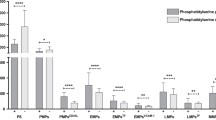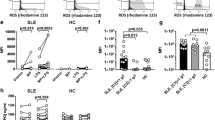Abstract
Microparticles are small membrane-bound vesicles that display pro-inflammatory and pro-thrombotic activities important in the pathogenesis of a wide variety of diseases. These particles are released from activated and dying cells and incorporate nuclear and cytoplasmic molecules for extracellular export. Of these molecules, DNA is a central autoantigen in systemic lupus erythematosus (SLE). As studies in our laboratory show, DNA occurs prominently in microparticles, translocating into these structures during apoptotic cell death. This DNA is antigenically active and can bind to lupus anti-DNA autoantibodies. These findings suggest that microparticles are an important source of extracellular DNA to serve as an autoantigen and autoadjuvant in SLE.

Similar content being viewed by others
References
VanWijk MJ, VanBavel E, Sturk A, Nieuwland R. Microparticles in cardiovascular diseases. Cardiovasc Res. 2003;59:277–87.
Cocucci E, Racchetti G, Meldolesi J. Shedding microvesicles: artefacts no more. Trends Cell Biol. 2009;19:43–51.
Beyer C, Pisetsky DS. The role of microparticles in the pathogenesis of rheumatic diseases. Nat Rev Rheumatol. 2010;61:21–9.
Orozco AF, Lewis DE. Flow cytometric analysis of circulating microparticles in plasma. Cytometry A. 2010;77A:502–14.
Hahn BH. Antibodies to DNA. N Engl J Med. 1998;338:1359–68.
Means TK, Latz E, Hayashi F, Murali MR, Golenbock DT, Luster AD. Human lupus autoantibody-DNA complexes activate DCs through cooperation of CD32 and TLR9. J Clin Invest. 2005;115:407–17.
Rönnblom L, Eloranta M-J, Alm GV. The type I interferon system in systemic lupus erythematosus. Arthritis Rheum. 2006;54:408–20.
Tian J, Avalos AM, Mao S-Y, Chen B, Senthil K, Wu H, Parroche P, Drabic S, Golenbock D, Sirois C, Hua J, An LL, Audoly L, La Rosa G, Bierhaus A, Naworth P, Marshak-Rothstein A, Crow MK, Fitzgerald KA, Latz E, Kiener PA, Coyle AJ. Toll-like receptor 9-dependent activation by DNA-containing immune complexes is mediated by HMGB1 and RAGE. Nat Immunol. 2007;8:487–96.
Schulze C, Munoz LE, Franz S, Sarter K, Chaurio RA, Gaipl US, Hermann M. Clearance deficiency—a potential link between infections and autoimmunity. Autoimmun Rev. 2008;8:5–8.
Lafyatis R, Marshak-Rothstein A. Toll-like receptors and innate immune responses in systemic lupus erythematosus. Arthritis Res Ther. 2007;9:222.
Casciola-Rosen LA, Anhalt G, Rosen A. Autoantigens targeted in systemic lupus erythematosus are clustered in two populations of surface structures on apoptotic keratinocytes. J Exp Med. 1994;179:1317–30.
Schiller M, Bekeredjian-Ding I, Heyder P, Blank N, Ho AD, Lorenz HM. Autoantigens are translocated into small apoptotic bodies during early stages of apoptosis. Cell Death Differ. 2008;15:183–91.
Pisetsky DS, Reich CF III. The influence of lipofectin on the in vitro stimulation of murine spleen cells by bacterial DNA and plasmid DNA vectors. J Interferon Cytokine Res. 1999;19:1219–26.
Zhu FG, Reich CF III, Pisetsky DS. Effect of cytofectins on the immune response of murine macrophages to mammalian DNA. Immunology. 2003;109:255–62.
Reich CF III, Pisetsky DS. The content of DNA and RNA in microparticles released by Jurkat and HL-60 cells undergoing in vitro apoptosis. Exp Cell Res. 2009;315:760–8.
Ullal AJ, Pisetsky DS. The release of Jurkat leukemia T cells treated with staurosporine and related kinase inhibitors to induce apoptosis. Apoptosis. 2010;15:586–96.
Harris HE, Raucci A. Alarmin(g) news about danger: workshop on innate danger signals and HMGB1. EMBO Rep. 2006;7:774–8.
Pisetsky DS, Erlandsson-Harris H, Andersson U. High-mobility group box protein 1 (HMGB1): an alarmin mediating the pathogenesis of rheumatic disease. Arthritis Res Ther. 2008;10:209.
Andersson U, Harris HE. The role of HMGB1 in the pathogenesis of rheumatic disease. Biochim Biophys Acta. 2010;1799:141–8.
Bonaldi T, Talamo F, Scaffidi P, Ferrera D, Porto A, Bachi A, Rubartelli A, Agresti A, Bianchi ME. Monocytic cells hyperacetylate chromatin protein HMGB1 to redirect it towards secretion. EMBO J. 2003;22:5551–60.
Gardella S, Andrei C, Ferrera D, Lotti LV, Torrisi MR, Bianchi ME, Rubartelli A. The nuclear protein HMGB1 is secreted by monocytes via a non-classical, vesicle-mediated secretory pathway. EMBO Rep. 2002;3:995–1001.
Jiang W, Pisetsky DS. The role of IFN-a and nitric oxide in the release of HMGB1 by RAW264.7 cells stimulated with polyinosinic-polycytidylic acid and lipopolysaccharide. J Immunol. 2006;177:3337–43.
Jiang W, Bell CW, Pisetsky DS. The relationship between apoptosis and high-mobility group protein 1 release from murine macrophages stimulated with lipopolysaccharide or polyinosinic-polycytidylic acid. J Immunol. 2007;178:6495–503.
Gauley J, Pisetsky DS. The release of microparticles by RAW264.7 macrophage cells stimulated with TLR ligands. J Leukoc Biol. 2010;87:1115–23.
Ullal AJ, Pisetsky DS, Reich CF III. Use of SYTO 13, a fluorescent dye binding nucleic acids, for the detection of microparticles in in vitro systems. Cytometry A. 2010;77:294–301.
Acknowledgments
These studies were supported by a VA Merit review grant and NIH grants AI082402 and AI083923.
Author information
Authors and Affiliations
Corresponding author
Rights and permissions
About this article
Cite this article
Pisetsky, D.S., Gauley, J. & Ullal, A.J. Microparticles as a source of extracellular DNA. Immunol Res 49, 227–234 (2011). https://doi.org/10.1007/s12026-010-8184-8
Published:
Issue Date:
DOI: https://doi.org/10.1007/s12026-010-8184-8




